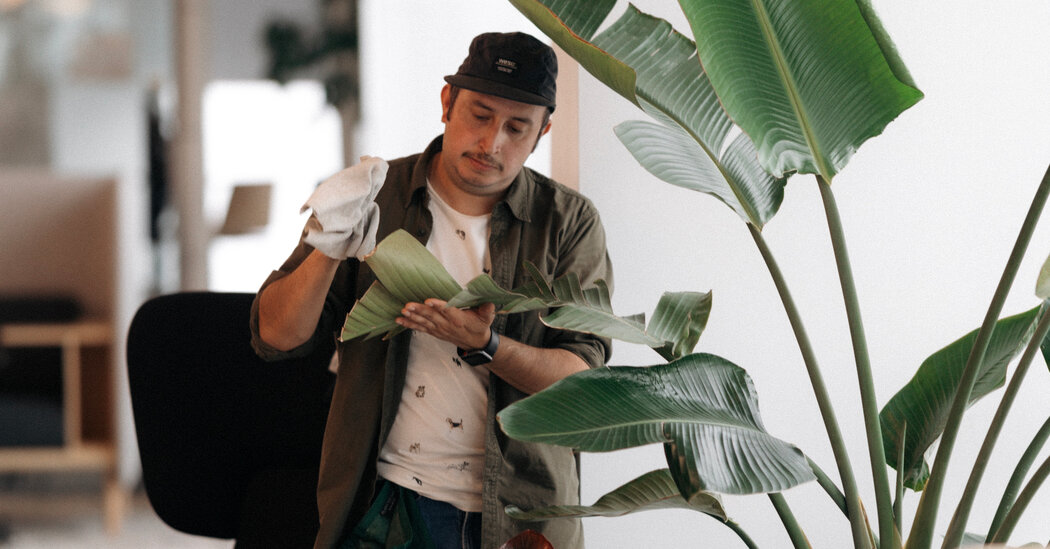Alaska’s Food Trucks – The New York Times
Last summer, on an overcast July day, the coastal town of Sitka, once the capital of Russian Alaska and long a popular stop on Inside Passage cruises in Southeast Alaska, was thronged with passengers disembarking from three cruise ships. To accommodate the crowds, the city had closed the main street to cars. In their place, food trucks, carts and stands had popped up, creating a festival atmosphere where ambulatory diners spooned seafood chowder and gobbled tacos.
“In summer, street food seems like the way to go in a place like this,” said Gretchen Stelzenmuller, who cooked professionally in San Francisco before moving back home to Sitka during the pandemic and opening her mobile food business, Enoki Eatery, which serves Japanese-inspired comfort food. “It’s healthy and uniquely celebrates Alaska ingredients, but you can also roll in and grab a bite and still do your tour.”
In the wake of the pandemic, as cruising returns to full strength in Alaska, food trucks and other vendors have proliferated in ports from Ketchikan to Seward.
“With a food truck, you can get into the restaurant business without the full brick-and-mortar entrepreneurial costs,” said Jon Bittner, the state director of the Alaska Small Business Development Center. “That’s pretty attractive in smaller communities that service cruise ships.”
For passengers with only a few hours in port and lots to see — including ferry riders taking the Alaska Marine Highway — food trucks offer local flare at relatively reasonable prices and in less time than full-service restaurants.
“Food trucks are a natural extension of what draws people to Alaska, being outside,” said Aaron Saunders, the senior editor at Cruise Critic.
Expect to pay a little more than in the Lower 48, given the high cost of living. Last summer, I bought a chicken and rice dish for $16 from a stand in Seward, a few dollars more and a free can of Pepsi less than the equivalent truck fare in New York City.
For the 2023 cruise season, which generally runs April to October, Alaska cruise authorities expect 1.65 million cruise passengers, up from the record of 1.3 million in 2019. Most will sail the Inside Passage, a roughly 500-mile route in Southeast Alaska that weaves through islands protecting it from the churn of the Pacific Ocean.
While ship-bound visitors may make their way through Anchorage — which has its own thriving food truck scene — the following popular cruise stops form a locally grown coastal culinary trail.
Ketchikan: Shrimp and grits and fried chicken sandwiches
Often the first call in Alaska for northbound Inside Passage cruises, Ketchikan — a traditional Tlingit fishing camp that today thrives on tourism, commercial fishing and forestry — booms with the arrival of cruise ships. Passengers disembarking for day trips in the Tongass National Forest or to see the totem poles at Saxman Native Village will find a few food stalls among the vendor booths on the cruise dock — including D’s Fish and Chip Shack — while more robust food-truck offerings can be found within walking distance.
“If you want to see someone make out with a chicken sandwich, come by our truck sometime,” wrote Thane Peterson, the owner of the food truck Chicke Chicke Bang Bang, which specializes in chicken sandwiches ($12), in an email. He described diners with “eyes closed, groaning, mumbling ‘Oh my god.’”
The truck, which launched last year, can often be found parked near the cruise docks, and passengers, Mr. Peterson said, account for two-thirds of annual sales.
A few blocks from the cruise berths, Amber Adams aims to open the town’s first food truck lot, Dock Street Yard, in August with room for three vendors.
After moving to Ketchikan from New Orleans four years ago, Ms. Adams found herself cooking Creole dishes with Alaskan ingredients as both a reminder of home and a necessity in a small town with few dining options. Currently the only tenant on the lot, her business, the Food Truck, will serve shrimp and grits ($15) and rib-eye banh mi po’ boys ($18).
“Starting a restaurant is scary,” Ms. Adams said on a break from prepping her truck. “But it’s a different beast here because of the huge influx of people for six months that basically doubles the population in town.”
Sitka: Smoked salmon musubi and seafood chowder
In the high season, disembarking passengers can match Sitka’s population of about 8,500. Again this year, the city is restricting the main thoroughfare, Lincoln Street, to foot traffic on days when cruise ship capacity in port exceeds 5,000, inviting mobile businesses to set up.
“I think it’s a really great way to showcase all the talent in this town,” said Ms. Stelzenmuller, who launched Enoki Eatery last year as a Lincoln Street pop-up serving variations of Hawaiian-style musubi, a wedge of rice topped with Spam or fish and bound by a seaweed wrap. “Street food should be a reason to come here.”
This year, she purchased a food truck and parked it downtown. The vehicle has allowed her to expand the menu, which may include steamed buns stuffed with pork or salmon and cream cheese ($9) and smoked salmon musubi ($8.50).
Just off Lincoln Street, behind Ernie’s Old Time Saloon, Barbara Palacios serves poke, chowder and ceviche from her cart, the Fresh Fish.
“We’re having a food-truck boom here in Sitka,” said Ms. Palacios, who plans to upgrade her vehicle later this year to a full-size food truck and continue offering poke (tuna or salmon, $18), halibut ceviche ($14) and seafood chowder ($9 a cup, $14 a bowl).
“It’s a labor of passion and love,” said Ms. Palacios, who often works 12 hours a day in season.
A few blocks east, past the Russian Orthodox St. Michael’s Cathedral, Ashley McNamee runs Ashmo’s, serving locally caught fish in smoked salmon macaroni and cheese ($9), black cod on coconut rice ($10) and lingcod sandwiches ($12).
Like many food truck operators here, Ms. McNamee, whose résumé includes 14 years cooking at an Alaskan fishing lodge, chose the food truck over “the restaurant grind.” Still, she added, “With the influx of people off cruise ships, it’s almost all I can do to keep up.”
From the center of town, it’s a little over a mile to Harbor Mountain Brewing Co., where Cambria Goodwin and Luke Bruckert base their brick-and-mortar Campfire Kitchen, a wood-oven pizza specialist. This year, they’ve added a mobile kitchen at the site to prepare fried chicken sandwiches ($15) and fried cheese curds ($9) to keep up with the crush of business.
In a separate endeavor, Ms. Goodwin recently opened Sitka Salmon Wagon, serving salmon bisque ($10 a cup, $16 a bowl) from a trailer parked downtown “to feed the masses,” she said.
The weather can be a challenge to outdoor dining in Southeast Alaska’s temperate rainforest. After one year running Blumen Dogs hot dog cart, Shawn Blumenshine is adding a food truck and will operate in several locations, serving Nathan’s Famous franks ($7) and creative versions ($11), including the Banh Mi Dog with carrots, cabbage, jalapeños, vinaigrette and sweet chili sauce. To date, patrons are largely local. “I’ve got hardcore banh mi fans,” said Mr. Blumenshine.
Juneau: Fish tacos and potato pizza
The state capital, Juneau, is no stranger to food carts and trucks. Trailblazers in town include Bernadette’s, a Filipino barbecue cart started in 1996 that draws lines of visiting cruise ship crew members, many of whom are Filipino, and Pucker Wilson’s, opened nine years ago, and dishing two-fisted burgers like the Huskey Dawson topped with bacon, onion rings and cheese ($16).
Visitors looking for Alaskan seafood on the go will find it a few blocks from the cruise pier at Deckhand Dave’s, a fish taco purveyor that anchors a food-truck yard. The truck and yard are run by Dave McCasland, a self-taught chef who worked for two years as a cook on a commercial fishing boat to pay off his college loans before launching his truck in 2016 with items like blackened rockfish tacos ($13.50 for three).
In 2019, he developed the food truck lot with room for the original business, a spinoff oyster and champagne bar and other mobile tenants, today including the Alaskan Crepe Escape and a cotton candy maker.
“People travel for a taste of place, and when they come to Alaska they really want to eat seafood and eat local,” said Midgi Moore, who runs Juneau Food Tours, guiding visitors to places like Deckhand Dave’s.
Five miles from downtown, in the direction of the Mendenhall Glacier, the Alaskan Brewing Company tasting room hosts food trucks, including Forno Rosso, serving wood-fired Neapolitan-style pizzas ($13 to $17 for 10-inch pies). Before moving to Juneau, the truck’s owners, Alexander and Kym Kotlarov, lived in Rome where they developed a passion for pizza that led to the mobile business named for their red-tiled oven.
If visitors find out-of-the-way Forno Rosso, they tend to be independent travelers or craft beer fans, according to Ms. Kotlarov, who uses specialty flour, San Marzano tomatoes from California and locally grown Genovese basil.
“I feel like we’re swimming upstream with our agenda of caring about quality and staying true to the Italian thing,” Ms. Kotlarov said, noting that she continues to offer Italian potato pizza as a special periodically.
Seward: Reindeer hot dogs and birria plates
A port on the Kenai Peninsula, roughly 130 miles south of Anchorage, Seward tends to get cruise ships at the start or end of their itineraries. On the road system, it also draws travelers by land.
“They disembark and embark in Seward,” said Kameron Weathers, the owner of Wild Spoon food truck and catering company. “We’re not a stop.”
Still, ship crew and road-trippers patronize her stand for souped-up reindeer or buffalo dogs topped with beet kimchi and ginger aioli ($10), and venison specials.
In summer 2020, despite the collapse of tourism during the pandemic, Faith Alderman and Fiona Crosby launched their breakfast-and-lunch business, the Porthole, to capture the early morning traffic at Seward Harbor with breakfast burritos ($12) and English muffin sandwiches ($8). Open at 4:30 a.m., the business draws captains, deckhands and visitors taking boat trips to the nearby Kenai Fjords National Park.
Seward travelers bound for Alaska SeaLife Center, an aquarium and marine research center on Resurrection Bay, can’t miss Los Chanchitos, a busy Mexican food truck that anchors a nearby lot shared by Early Bird coffee truck and an ax-throwing business. It specializes in birria or beef brisket tacos ($17), among other fare.
Peter Cavaretta, who spent more than a decade in the southern Baja Peninsula, opened the truck last April after visiting his sister in Seward and seeing “lines out the door for semi-average food at high prices,” he said. “I wanted to do super-good food at moderate prices.”


